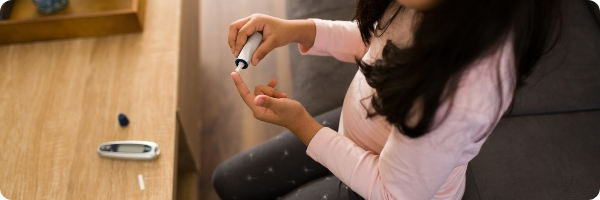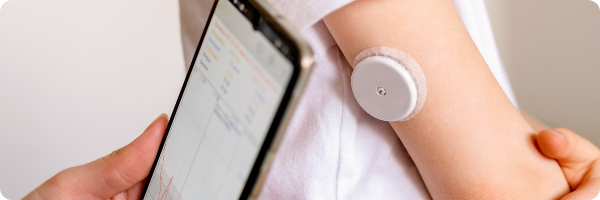What is type 1 diabetes?
If someone has type 1 diabetes, this means that their immune system attacks and destroys the insulin-producing cells in the pancreas. Insulin is needed to help blood sugar enter the cells in your body, and without it, blood sugar builds up in the bloodstream – which can lead to various health complications.
Type 1 diabetes is a lifelong condition that can develop at any age. However, it’s most commonly seen in children, teens, and young adults. This explains why type 1 diabetes is sometimes referred to as ‘juvenile diabetes’.
Although there is not yet any evidence that suggests how type 1 diabetes can be prevented, there are many ways that it can be treated and managed.
What’s the difference between type 1 and type 2 diabetes?
Type 1 diabetes is less common than type 2 – as only 5-10% of people with diabetes are diagnosed with type 1. Someone would have type 1 diabetes if their body’s immune system attacks the cells that produce insulin. On the other hand, if someone has type 2 diabetes, their body doesn’t produce enough insulin, or the body’s cells don’t react to insulin.
The biggest difference between the conditions is that type 1 is a genetic condition that can present itself early on in life, whereas type 2 develops over time, and the causes can be lifestyle related.

What are the symptoms of type 1 diabetes?
It’s important to note that some people with type 1 diabetes might only display mild symptoms, so it may go unnoticed. Not to mention, some of the symptoms of type 1 diabetes may overlap with other medical conditions, so if you’re ever unsure, always book a doctor’s appointment. There are also some similarities between type 1 and type 2 diabetes symptoms, but the causes and treatment options differ.
Common symptoms of type 1 diabetes
- Feeling very thirsty
- Breath that smells fruity
- Peeing more than usual, especially during the night
- Feeling very tired
- Recurring thrush
- Blurry vision
- Losing weight without trying
- Cuts and grazes that don’t heal
Less common symptoms of type 1 diabetes
- Darker area of skin on the neck (acanthosis nigricans)
- Recurring urinary tract infections and some skin problems
- Sexual dysfunction
- Irritability
- Itching
- Limb pain due to nerve damage (diabetic neuropathy)
- Dry mouth
- Stomach problems and nausea
Symptoms of type 1 diabetes in children
The following symptoms may present themselves in children who have type 1 diabetes:
- Extreme thirst or hunger
- Feeling fatigued
- Irritability or changes in behaviour
- Breath that smells fruity
- Frequent urination – a toilet-trained child may wet the bed
- Unintentional weight loss
The signs and symptoms displayed by children with type 1 diabetes usually develop quickly, so early treatment is key.

Managing type 1 diabetes
Managing type 1 diabetes can be challenging, but there are things you can do to help keep your body healthy. Remember that you are in charge of your own diabetes. With proper management, you should only need to see your doctor rarely. Being able to stay fit and well with diabetes means that you need to understand the disease and its management, and feel able to discuss with the NHS what you need to help yourself as much as possible.
Taking insulin
Everyone with type 1 diabetes is required to take insulin to help manage blood glucose (sugar) levels. By efficiently managing your blood sugar levels, you’ll reduce your risk of developing future diabetes-related complications. Insulin can be taken using the following methods:
Insulin pen
When injected, the needle of a prescribed insulin pen will deliver insulin into the subcutaneous tissue (which is the tissue between your skin and your muscle). The amount of insulin you need to inject will be personal to you, and your doctor will inform you on the amount needed.
Insulin pumps
An insulin pump is an electrical device that releases small, predetermined amounts of insulin into your body throughout the day and night, so you won’t need to inject it. Although an insulin pump may not suit everyone, it does provide more flexibility with what you eat, and it can help to stabilise blood glucose levels.
Islet cell transplant
An islet cell transplantation is a minor procedure, where islet cells are extracted from a deceased donor’s pancreas. These cells will then be implanted into the liver of someone who has type 1 diabetes. Recipients will need to take anti-tissue rejection medications, which can cause complications.
Leading a healthy lifestyle
Emotional factors
All long-term conditions carry an emotional burden, diabetes perhaps more than most as it affects so many aspects of your life, and your family’s. Depression and anxiety are common, so talk to your family and friends as bottling up emotions is never helpful. If the solutions you’re trying aren’t easy, and your mood is persistently affecting your life, your GP practice will be able to help in lots of ways, and private counselling options will be available.
Diet for diabetes
To help manage your blood sugar levels, a healthy, balanced diet is recommended. Most foods are fine for those who have type 1 diabetes, so long as you manage your insulin to keep your blood sugar low and stable. If you get thirsty – which is a common symptom of type 1 diabetes – try to avoid sugary drinks and fruit juices to avoid a spike in your blood sugar.
Your diet should include food from all the main food groups. Managing carbohydrate consumption is especially important. You’ll need to see how much carbohydrates suit you in which circumstances, for instance when exercising or when sedentary for long periods. The type of carbohydrates you eat is important, so replenish your cupboards with plenty of wholegrains, pulses, unsweetened yoghurt, nuts and seeds, and fruit and veg.
Exercising with diabetes
If you have type 1 diabetes, you can still take part in sports and exercise. In fact, it’s a great way to improve your mental and physical health, and can even reduce post-meal glucose spikes. However, some extra care is needed to ensure that you exercise safely. Depending on the activities you engage in, these may affect your blood sugar levels. For example, moderate exercise that lasts a while, such as walking or cycling, could cause your blood glucose levels to slowly drop. Whereas exercises such as running or football can cause your blood glucose levels to rise.
There’s no one-size-fits-all approach when it comes to exercise, so see which activities you benefit from the most. Make sure to keep an eye on your blood glucose levels throughout, drink plenty of water, and avoid spikes by eating healthy carbs before, during, and after exercising.

Apps for diabetes
Thanks to developments in modern technology, there are a number of apps that can make diabetes management simpler – such as Flash glucose monitors (Freestyle Libre) and continuous glucose monitors (CGM). Apps such as Evergreen Life help you to take control of your health information, allowing you to connect to your GP record, order repeat prescriptions, and easily book appointments. There are also apps that are designed to provide newly diagnosed individuals with the space to connect and share experiences with one another, and others that can help you figure out which foods will keep your blood sugar within a healthy range.
Practical considerations
A diabetes diagnosis can feel overwhelming at first, but there are a number of fantastic resources that can help you deal with what’s to come. DiabetesUK is a great website to visit for advice, support and a like-minded community.
Insurance
If you’ve been diagnosed with type 1 diabetes, you may be all too familiar with issues surrounding insurance – whether that’s life insurance, driving insurance, or travel insurance, to name a few. Depending on the type of insurance, some extra care may need to be taken to prevent any future issues. An independent financial or other professional advisor can help you make these important decisions.
Although most people with diabetes are able to drive without concern, there are still certain factors that should be taken into consideration. This includes whether you’re at risk of hypoglycaemia (which is when your blood sugar level drops too low), or if you display symptoms of diabetes that might make it harder to drive, such as eye problems (retinopathy) or nerve damage (neuropathy). Also, the vehicle you drive will come into play, as certain cars can be more complicated to drive if you have diabetes. As always, if you’re ever unsure of whether it’s safe for you to drive, have a chat with your doctor.
Not everyone with diabetes experiences sexual problems. However, if this does apply to you, know that you’re not alone. There are professionals who can help with anything from relationship advice to talking through any negative emotions you may be experiencing as a result. You should also communicate your thoughts or concerns with a partner as much as you can, which will make diabetes management much easier.
If your child is diagnosed with type 1 diabetes
A child being diagnosed with diabetes can be overwhelming, but there are people out there to support you. If your child does receive the diagnoses, they’ll be taken care of by a children’s (paediatric) diabetes team until the age of 17 or 18. The team will provide advice on how to manage diabetes, such as how and when to take insulin injections, how to test blood glucose levels, and how to safely adjust your child’s diet. To make sure that you’re managing, the care team might arrange appointments with you every one or two weeks. Once you feel more confident, these appointments will be less frequent – changing to once every three months.
Take away
Type 1 diabetes is manageable, but it should still be taken seriously. Having a good relationship with your practice, and communicating regularly with your healthcare provider, makes receiving the treatment you need much easier. Ultimately, shared decision-making is key here. Your GP can also advise on managing the emotional components commonly associated with diabetes, such as anxiety and depression, but your post-diagnosis plan of action will always be unique to you.
Take control of your health and wellbeing. Download the Evergreen Life app today, and own your GP medical history.
Reviewed by:
Anna Keeble – Head of Content
- American Academy of Dermatology. (2022). Diabetes: 12 warning signs that may appear on your skin. American Academy of Dermatology.
- American Diabetes Association. (2021). Diabetes and skin complications. American Diabetes Association.
- American Diabetes Association. (2022). Type 1 Diabetes Symptoms. American Diabetes Association.
- Centers for Disease Control and Prevention. (2022). What is Type 1 diabetes? Centers for Disease Control and Prevention.
- Cleveland Clinic. (2022). Diabetes and Dry Mouth. Cleveland Clinic.
- Cleveland Clinic. (2018). Insulin Pen Injections. Cleveland Clinic.
- Diabetes.co.uk. (2022). Dizziness. Diabetes.co.uk.
- Diabetes.co.uk. (2022). Urinary Tract Infections – UTIs. Diabetes.co.uk.
- Diabetes UK. (2022). Diabetes and sexual problems – in men. Diabetes UK.
- Diabetes UK. (2022). Diabetes treatments. Diabetes UK.
- Diabetes UK. (2022). Differences between type 1 and type 2 diabetes. Diabetes UK.
- Diabetes UK. (2021). Driving and diabetes. Diabetes UK.
- Diabetes UK. (2022). I have type 1 – diabetes what can I eat? Diabetes UK.
- Diabetes UK. (2019). Insurance and diabetes. Diabetes UK.
- Diabetes UK. (2022). Islet cell transplants for type 1 diabetes. Diabetes UK.
- Diabetes UK. (2020). Sex and diabetes. Diabetes UK.
- Mayo Clinic. (2022). Diabetic neuropathy. Mayo Clinic.
- Mayo Clinic. (2022). Type 1 diabetes in children. Mayo Clinic.
- Medical News Today. (2022). How does diabetes affect mood and relationships? Medical News Today.
- NHS UK. (2019). Diabetes. NHS UK.
- NHS UK. (2021). Insulin pumps. NHS UK.
- NHS UK. (2019). Type 1 diabetes. NHS UK.
- NHS UK. (2021). Types 1 diabetes – Symptoms and getting diagnosed. NHS UK.
- NHS UK. (2021). Type 1 diabetes in children. NHS UK.
- NHS UK. (2021). Type 1 diabetes – Exercise and sport. NHS UK.
- WebMD. (2021). When Diabetes Causes Stomach Problems. WedMD.





